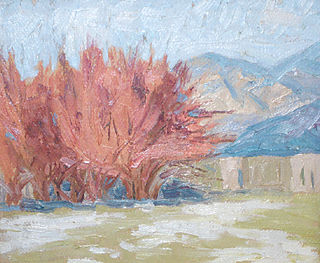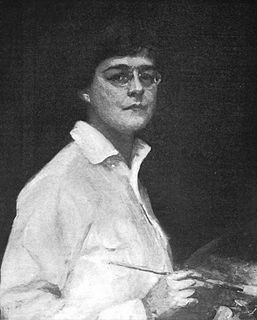Related Research Articles

Taos is a town in Taos County in the north-central region of New Mexico in the Sangre de Cristo Mountains. It was founded by Nuevo México Governor Fernando Chacón in 1795, to act as fortified plaza and trading outpost for the neighboring Native American Taos Pueblo and Hispano communities, including Ranchos de Taos, Cañon, Taos Canyon, Ranchitos, El Prado, and Arroyo Seco. The town was incorporated in 1934. As of the 2010 census, its population was 5,716.

The Taos art colony was an art colony founded in Taos, New Mexico, by artists attracted by the rich culture of the Taos Pueblo and the beautiful land and light of northern New Mexico. The history of Hispanic craftsmanship in furniture, tin work and more also played a role in creating a multicultural tradition of art in the area.

Ernest Leonard Blumenschein was an American artist and founding member of the Taos Society of Artists. He is noted for paintings of Native Americans, New Mexico and the American Southwest.

Bert Geer Phillips was an American artist and a founding member of the Taos Society of Artists. He settled in Taos, New Mexico (1898) and was a founder of the Taos art colony. He is known for his paintings of Native Americans, New Mexico, and the American Southwest. He was also a benefactor of the Western artist Harold Dow Bugbee, who became curator of the Panhandle-Plains Historical Museum in Canyon, Texas in 1951.

William Herbert "Buck" Dunton was an American artist and a founding member of the Taos Society of Artists. He is noted for paintings of cowboys, New Mexico, and the American Southwest.
Oscar Edmund Berninghaus was an American artist and a founding member of the Taos Society of Artists. He is best known for his paintings of Native Americans, New Mexico and the American Southwest. His son, Charles Berninghaus (1905–1988), was also a Taos artist.
Ernest Martin Hennings (1886–1956) was an American artist and member of the Taos Society of Artists.

Walter Ufer was an American artist based in Taos, New Mexico. His most notable work focuses on scenes of Native American life, particularly of the Pueblo Indians.
Events from the year 1960 in art.

Joseph Henry Sharp was an American painter and a founding member of the Taos Society of Artists, of which he is considered the "Spiritual Father". Sharp was one of the earliest European-American artists to visit Taos, New Mexico, which he saw in 1893 with artist John Hauser. He painted American Indian portraits and cultural life, as well as Western landscapes. President Theodore Roosevelt commissioned him to paint the portraits of 200 Native American warriors who survived the Battle of the Little Bighorn. While working on this project, Sharp lived on land of the Crow Agency, Montana, where he built Absarokee Hut in 1905. Boosted by his sale of 80 paintings to Phoebe Hearst, Sharp quit teaching and began to paint full-time.

The Ernest L. Blumenschein House is a historic house museum and art gallery at 222 Ledoux Street in Taos, New Mexico. It was a home of painter Ernest L. Blumenschein (1874-1960), a co-founder of the Taos Society of Artists and one of the "Taos Six". It was declared a National Historic Landmark in 1965.
The Taos Society of Artists was an organization of visual arts founded in Taos, New Mexico. Established in 1915, it was disbanded in 1927. The Society was essentially a commercial cooperative, as opposed to a stylistic collective, and its foundation contributed to the development of the tiny Taos art colony into an international art center.

Cordelia Creigh Wilson was a painter noted for her landscapes of New Mexico and the American Southwest.
The Roswell Museum and Art Center is located in Roswell, New Mexico, United States, and features exhibits about the art and history of the American Southwest. Exhibits include fine art, sculpture, prints, decorative arts, and historic artefacts.

The Eanger Irving Couse House and Studio—Joseph Henry Sharp Studios, also known as the Couse/Sharp Historic Site, is a property on the U.S. National Register of Historic Places. It includes the home and art studio of E. Irving Couse (1866–1936) and two studio buildings owned by Joseph Henry Sharp (1859-1953), both founding members of the Taos Society of Artists. It was added to the NRHP on September 28, 2005.

The Harwood Museum of Art is located in Taos, New Mexico. Founded in 1923 by the Harwood Foundation, it is the second oldest art museum in New Mexico. Its collections include a wide range of Hispanic works and visual arts from the Taos Society of Artists, Taos Moderns, and contemporary artists. In 1935 the museum was purchased by the University of New Mexico. Since then the property has been expanded to include an auditorium, library and additional exhibition space.
Mary Shepard Greene Blumenschein (1869–1958) was an American artist, illustrator and jewelry designer.
Alyce Frank is an American landscape painter.
Rebecca Salsbury James (1891–1968) was a self-taught American painter, born in London, England of American parents who were traveling with the Buffalo Bill Wild West Show. She settled in New York City, where she married photographer Paul Strand. Following her divorce from Strand, James moved to Taos, New Mexico where she fell in with a group that included Mabel Dodge Luhan, Dorothy Brett, and Frieda Lawrence. In 1937 she married William James, a businessman from Denver, Colorado who was then operating the Kit Carson Trading Company in Taos. She remained in Taos until her death in 1968.

Harriet Blackstone was an American figure and portrait painter. Many of her subjects were midwestern business leaders and their families she also painted a number of prominent musicians.
References
- 1 2 Walter, Paul Alfred Francis, and Lansing Barlett Bloom. "New Mexico in the Great War", part VII. New Mexico Historical Review 1:4 (October 1926), p. 418.
- 1 2 3 4 5 6 7 8 9 Walter, Paul A.F. "Art in War Service". Art and Archaeology 7 (January—December 1918), pp. 395–403, 409.
- 1 2 3 Hassrick, Peter H., Elizabeth J. Cunningham, and Ernest Leonard Blumenschein. In Contemporary Rhythm: The Art of Ernest L. Blumenschein, p. 113. University of Oklahoma Press, 2008.
- 1 2 3 Larson, Robert W., and Carole B. Larson. Ernest L. Blumenschein: The Life of an American Artist. University of Oklahoma Press, 2013.